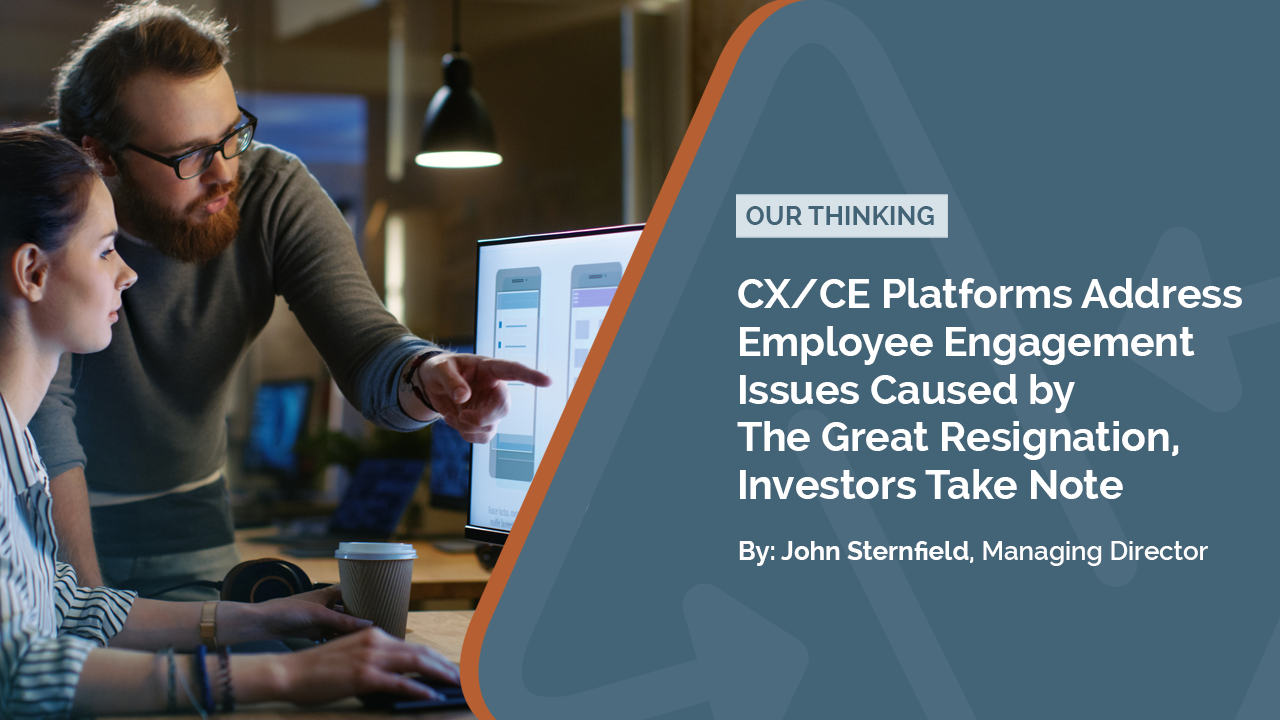CX/CE Platforms Address Employee Engagement Issues Caused
by The Great Resignation,
Investors Take Note
By: John Sternfield, Managing Director, Nfluence Partners
jsternfield@nfluencepartners.com

Some forward-thinking technology platforms initially designed to be deployed on the frontlines of customer experience and engagement (CX/CE) are now pivoting to tackle the next daunting challenge of the Digital Age—The Great Resignation. Most of the American workforce has either taken part in or felt the repercussions of the phenomenon, with a record 47 million Americans leaving their jobs in 2021. [1]
The trickle-down effects caused by worker shortages have been top of mind since COVID sent much of the workforce home, but the issues underpinning the “big quit” were brewing long before the pandemic. As a result, a focus on employee engagement has emerged as a strong trend in 2022, and CX/CE companies are deploying solutions to help employers attract more qualified candidates while keeping their existing employees happy.
Bridging the Employee/Employer Gap
There is a metaphorical Grand Canyon between what most employers think they are delivering to their employees and what employees want and/or are actually experiencing. In one McKinsey & Company study, employees cited leaving their jobs for a combination of primarily psychological factors—they didn’t feel valued by their organizations (54%), didn’t feel valued by their managers (52%), or didn’t feel a sense of belonging at work (51%). Meanwhile, when employers were asked why their employees quit, they cited compensation, work-life balance, and poor physical/emotional health. [2]
The widening gap between what employees want and what employers provide has created a chasm that employee engagement and experience (EX/EE) tools can help fill. It’s clear that employees need to be heard, and more and more companies are recognizing the need to invest in employee engagement. Fortunately, CX/CE platforms likely already have the means to take advantage of this gap in the market. Engagement SaaS platforms can empower their customers to thrive amid the new HR paradigm by layering employee-focused use cases on top of their existing consumer-focused use cases. Adapting and marketing the CX/CE tech toward the employee experience is a strategic move that can open up a broader addressable market and increase revenue potential.
Three Ways CX/CE Platforms are Addressing EX/EE
First-movers like Medallia, SAP, Salesforce, and Oracle are leading the way by repurposing the existing CX/CE software they’ve already developed, implemented, and marketed into programs aimed at simplifying and enhancing the employee experience:
1. Engaging Existing Employees: Bringing work into the home allowed the workforce to reevaluate its priorities—Forbes noted that employees want improved benefits such as healthcare, education, and childcare, as well as a more competent cultural environment with improved ESG and gender parity. [3] Rather than employers treating the employee experience as a second thought, engagement SaaS platforms are equipping leadership and HR teams with the tools to improve and enhance the entire employee journey, much the same way they have historically equipped marketing and sales teams to improve the customer journey. This includes survey, chat, review, asynchronous communication, reward, loyalty, and like applications aimed at internal stakeholders versus external ones.
2. Attracting Potential Employees: Employee engagement begins well before the team member’s first day. In today’s competitive recruiting environment, companies need to leverage technology to deploy a high-touch recruitment process at scale, starting with a great digital first impression. Tools for the recruitment process—including real time prospective candidate chat platforms and candidate experience feedback tools—are just a few ways companies are tackling the demands of 2022’s more human approach to recruitment. New employee success efforts are also mirroring the industry’s shift from customer support (complaint-focused/reactive) to customer success (education-based/proactive)—providing tools for smoother onboarding, digital solutions for training and development, and even virtual team engagement and cultural involvement with new hires.
3. Providing Actionable Data for Management and HR Teams: Nothing spurs action among management teams like cold, hard data. Deploying highly customizable reporting interfaces allows employers to leverage engagement platforms to make effective operational, HR, and financial decisions. And a focus on employee engagement does impact the bottom line—studies conducted by experience management SaaS platform Medallia show that employee experience heavily influences human resources outcomes, such as employee retention and satisfaction. [4] The same group’s studies reflected that companies were 12x more likely to report at least 20% growth in revenue over a one-year period when their leaders focused on employee experience. In addition, companies in the “top quartile of (employee) engagement realize substantially better customer engagement, higher productivity, better retention, fewer accidents, and 21% higher profitability,” [5] according to Gallup.
Integrating employee experience into their engagement platforms can position CX/CE companies to offer compelling additional value-add to their existing customers. It can also help the companies stand out as leaders among their peers.
From a strategic perspective, investors and strategic buyers are looking for management teams who are unafraid to adapt to the unexpected and are in tune with the cultural shifts of the workforce. For fundraising and exit considerations, they will likely favor those who have successfully pivoted or added well targeted offerings in the face of adversity by analyzing market opportunities and making strategic moves to exponentially expand their Total Addressable Market.
In addition to offering solutions to customers, CX/CE companies should look internally to evaluate and address any employee engagement gaps—starting with deploying their own platforms just as their customers would. Companies that can internally leverage the employee engagement tools they’ve developed can increase retention and productivity—two factors that investors also value.
Although the intersection of the Great Resignation and COVID seemingly upended the workforce, some CX/CE companies are adapting and thriving by bringing creative solutions to market quickly. Not only can finding a niche in the employee engagement world benefit the business and its employees in the short term, but investors may reward the company for its ingenuity in the long run.















